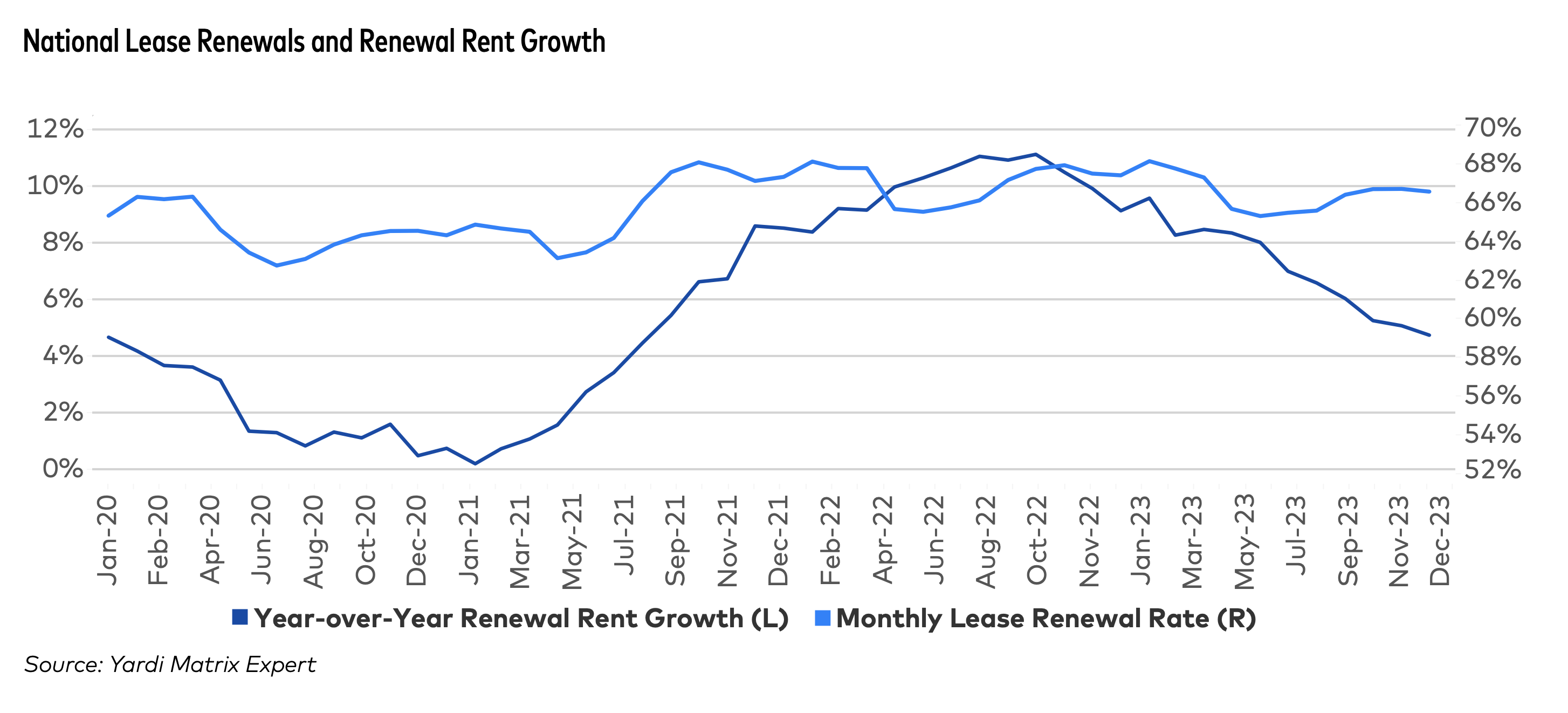National asking rents posted their first increase in over seven months in February, according to the latest Yardi Matrix National Multifamily Report. The average U.S. asking rent rose $1 to $1,713 in February 2024, up 0.6% year-over-year (YoY), while occupancy decreased 60 basis points YoY to 94.5% as of January.
Markets in the Northeast and Midwest continued to register rent increases, in contrast to rent contractions in high-supply Sun Belt markets. Of Yardi Matrix's top 30 metros, 13 posted rent declines, and five were down by three percent or more YoY. Occupancy was positive only in San Francisco, up 0.1%.
National Average Multifamily Rents

Yardi Matrix Multifamily Rent Report for February 2024
Rent prices for the Renter-by-Necessity (RBN) segment were up 0.1% while luxury Lifestyle rentals stayed flat. The biggest dips were in Austin, Texas, and Raleigh, N.C. Rents in both segments dipped in these cities (down 0.4% in RBN and 0.6% in Lifestyle for Austin; down 0.4% in RBN and 0.5% in Lifestyle for Raleigh). Most other markets remained stagnant or saw minor fluctuations.
New apartment construction seems to be cooling the rental market in some areas. Cities with a recent surge in new units, like Austin, Miami, and Charlotte, are experiencing the steepest declines in rent and occupancy. Conversely, cities with less construction are seeing healthy rent growth. In fact, out of eight major cities with minimal new construction over the past year, only Las Vegas has seen rents decrease.
While multifamily rents generally show signs of stability, factors including supply, demand, regional metrics and affordability will determine the market's 2024 performance. Occupancy is likely to continue to decline, with one million new rental units expected to come online through the end of 2025. Already, heavy deliveries in Sun Belt and Southwest metros have eroded rent growth, with more construction underway.

"While high-demand markets are likely to record weak rent growth over the next year or two, the seeds of a rebound have been planted, as starts are declining and deliveries will drop in 2026 and 2027," states the report.
Gain more insight in the new Yardi Matrix National Multifamily Report.
Yardi Matrix offers the industry's most comprehensive market intelligence tool for investment professionals, equity investors, lenders and property managers who underwrite and manage investments in commercial real estate. Yardi Matrix covers multifamily, student housing, vacant land, industrial, office, retail and self storage property types. Email matrix@yardi.com, call 480-663-1149 or visit yardimatrix.com to learn more.
RELATED
- Multifamily rent growth rate unchanged at 0.3%
- Multifamily rent remains flat at $1,710 in January
- Multifamily housing starts and permitting activity drop 10% year-over-year
About Yardi
Yardi develops industry-leading software for all types and sizes of real estate companies across the world. With over 9,000 employees, Yardi is working with our clients to drive significant innovation in the real estate industry. For more information on how Yardi is Energized for Tomorrow, visit yardi.com.
Related Stories
MFPRO+ Research | Aug 6, 2024
Matrix multifamily report for July shows ‘hopeful signs’
The multifamily market is showing strength in many ways, according to the July 2024 Matrix Multifamily National Report by Yardi Matrix.
Military Construction | Aug 5, 2024
Military housing presents opportunities and challenges to its private builders and landlords
At least one developer-builder, The Michaels Organization, bets on future construction and renovation.
MFPRO+ News | Aug 1, 2024
Canada tries massive incentive program to spur new multifamily housing construction
Canada has taken the unprecedented step of offering billions in infrastructure funds to communities in return for eliminating single-family housing zoning.
Student Housing | Jul 31, 2024
The University of Michigan addresses a decades-long student housing shortage with a new housing-dining facility
The University of Michigan has faced a decades-long shortage of on-campus student housing. In a couple of years, the situation should significantly improve with the addition of a new residential community on Central Campus in Ann Arbor, Mich. The University of Michigan has engaged American Campus Communities in a public-private partnership to lead the development of the environmentally sustainable living-learning student community.
MFPRO+ New Projects | Jul 31, 2024
Shipping containers converted into attractive, affordable multifamily housing in L.A.
In the Watts neighborhood in Los Angeles, a new affordable multifamily housing project using shipping containers resulted in 24 micro-units for formerly unhoused residents. The containers were acquired from a nearby port and converted into housing units at a factory.
MFPRO+ News | Jul 24, 2024
Most popular cities for renters mid-2024
Rental activity in the U.S. continues to grow halfway through 2024. With the work-from-home boom stabilizing, more renters are eying desirable cities to relocate to.
MFPRO+ News | Jul 22, 2024
Miami luxury condominium tower will have more than 50,000 sf of amenities
Continuum Club & Residences, a new 32-story luxury condominium tower in the coveted North Bay Village of Miami will feature more than 50,000 sf of indoor and outdoor amenities. The program includes a waterfront restaurant, dining terraces with resident privileges, and a private dining room outdoor pavilion.
MFPRO+ News | Jul 22, 2024
6 multifamily WAFX 2024 Prize winners
Over 30 projects tackling global challenges such as climate change, public health, and social inequality have been named winners of the World Architecture Festival’s WAFX Awards.
MFPRO+ News | Jul 15, 2024
More permits for ADUs than single-family homes issued in San Diego
Popularity of granny flats growing in California
Vertical Transportation | Jul 12, 2024
Elevator regulations responsible for some of ballooning multifamily costs
Codes and regulations for elevators in the United States are a key factor in inflating costs of multifamily development, argues a guest columnist in the New York Times.


















